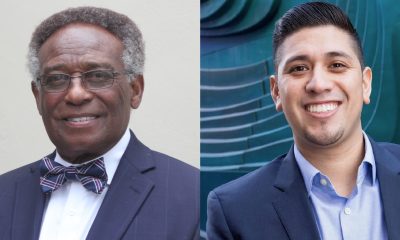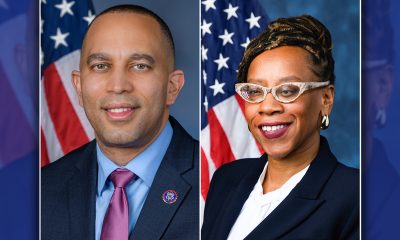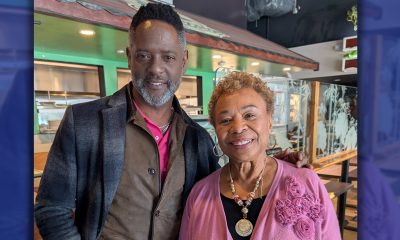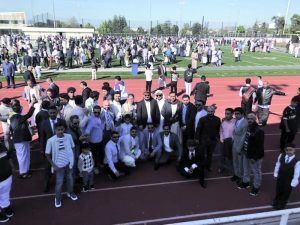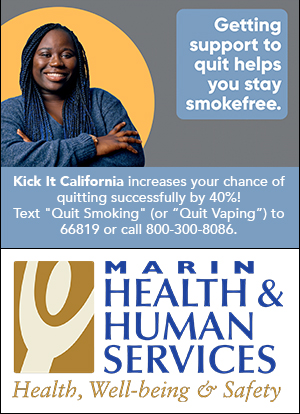Bay Area
Truth, Racial Healing, and Transformation (TRHT) Resolution
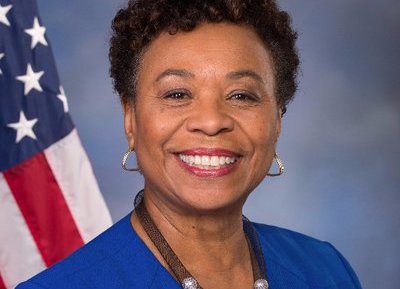
Rep. Barbara Lee issued a resolution calling for the formation of a Truth, Racial Healing, and Transformation Commission on Monday.
The resolution will be officially introduced June 4, 2020. It has 28 co-sponsors and has been in the works for three years.
The commission will address the legacy of slavery and racism, discrimination, and the historical impact of laws and policies.
TRHT parallels South Africa’s Truth and Reconciliation Commission which was established in 1996 as a restorative justice tribunal post Apartheid.
The resolution was revealed in a press call that included Rep. Karen Bass, who heads the Congressional Black Caucus; Rep. Deb Haaland, co-chair of the Congressional Native American Caucus; Rep. Jesus “Chuy” Garcia, Rep.Adriano Espaillat, Rep. Grace Meng, Rep. Jim McGovern, Wade Henderson, former president of the Leadership Conference on Civil and Human Rights, Dr. Gail Christopher, executive director of the National Collaborative for Health Equity and Former Rep. Tom Perriello, executive director of Open Society –U.S.
“The murder of George Floyd and the current COVID-19 crisis illustrate once again the painful and dangerous legacy that white supremacy has had in our country, and the desperate need to fully acknowledge and understand how our history of inequality continues today,” Lee said.
“This inequality is at the heart of every crisis we’re dealing with right now – – the crises of police brutality and mass incarceration, the COVID—19 public health crisis which is disproportionately affecting communities of color and the crisis of poverty excluding so many minority families from the American Dream.
“This is a matter of survival for countless Americans. Only by understanding our past, and confronting the errors that still haunt us today, can we truly move forward as a people and a country” said Lee said.
“I commend my colleague Congresswoman Barbara Lee for introducing this resolution to help this nation begin the process of healing, “ added Bass.
“The pain our country feels is rooted in generations of institutional racism,” Bass continued. “People of color are dying unjust deaths at the hands of power abusers. Whether it be the abuse of power that poisons the air and water surrounding communities of color, taking away protections for undocumented young people, underfunding Tribes putting them at a disproportionate risk during a pandemic, or police brutality that kills unarmed Black people, we must untangle the racist webs that are woven into our laws and policies on the books, so that we can take action,” said Haaland, who is a New Mexico representative.
“Our nation has witnessed a horrific week of events that has left communities mourning,” said Espaillat, a representative of New York. “After more than 400 years of oppression in America, Black men continue to be targeted, Latino families continue to be separated, and all persons of color, continue to be marginalized. More that 100,000 individuals have died during a pandemic that continues to wreak havoc on communities of color at far greater portions.
“It’s time for action and effort from each of us, together and united to ensure that the change we see happening around the country today is different. There has to be urgent resolve and healing because we cannot afford to go back to business as usual in the face of such challenges,” Espaillat concluded.
“The Truth, Racial Healing, and Transformation (TRHT) Resolution comes at a most timely moment, as our nation faces, yet again, the structural and brutal racism that affects communities of color, especially African Americans,” said Meng of New York.
“During this coronavirus pandemic, Asian Americans have been discriminated against and verbally and physically assaulted. When those attacks occurred, the African American community denounced those incidents and called for justice. Today, the Asian American community must stand in solidarity with them. Only together can we truly reconcile, heal, and transform our nation. I am proud to support this critical resolution, because our nation must come to grips with our ugly past—and present. We must acknowledge that our system is broken, and that we have to fix it. Ultimately, I want my children—all children—to grow up in a better world.”
“Justice and reconciliation must begin with serious self-reflection and an acknowledgment of the long and painful history of racism in America that has created the disparities we see today,” Rep. McGovern of Massachusetts. “For many of us, that means taking time to acknowledge how we have benefitted from systems of injustice and oppression and then working to uproot racism and discrimination whenever and wherever we see it in our lives. I am grateful to Representative Lee for introducing this legislation so we ca begin to heal our country by acknowledging our past. I look forward to working with her to advocate for this important bill.”
“Every day offers new examples of the tragic cost racism imposes on our country. I’ve learned, from transitional justice work overseas and my time in office in Virginia, that hate left unchecked only repeats and escalates” said former Rep. Tom Perriello.
Joe Biden vowed on Monday to address “institutional racism” in his first 100 days in office during a meeting with community leaders at Bethel AME church in Wilmington, Del.
Congresswoman Lee co-chairs the Steering Policy Committee, is a senior member of the Appropriations Committee, the former chair of the Congressional Black Caucus, is chair emeritus of the Progressive Caucus, and co-chair of the Pro-Choice Caucus. She is also chair of the of the Majority Leader Task Force of Poverty and Opportunity.
Activism
Oakland Post: Week of December 31, 2025 – January 6, 2026
The printed Weekly Edition of the Oakland Post: Week of – December 31, 2025 – January 6, 2026
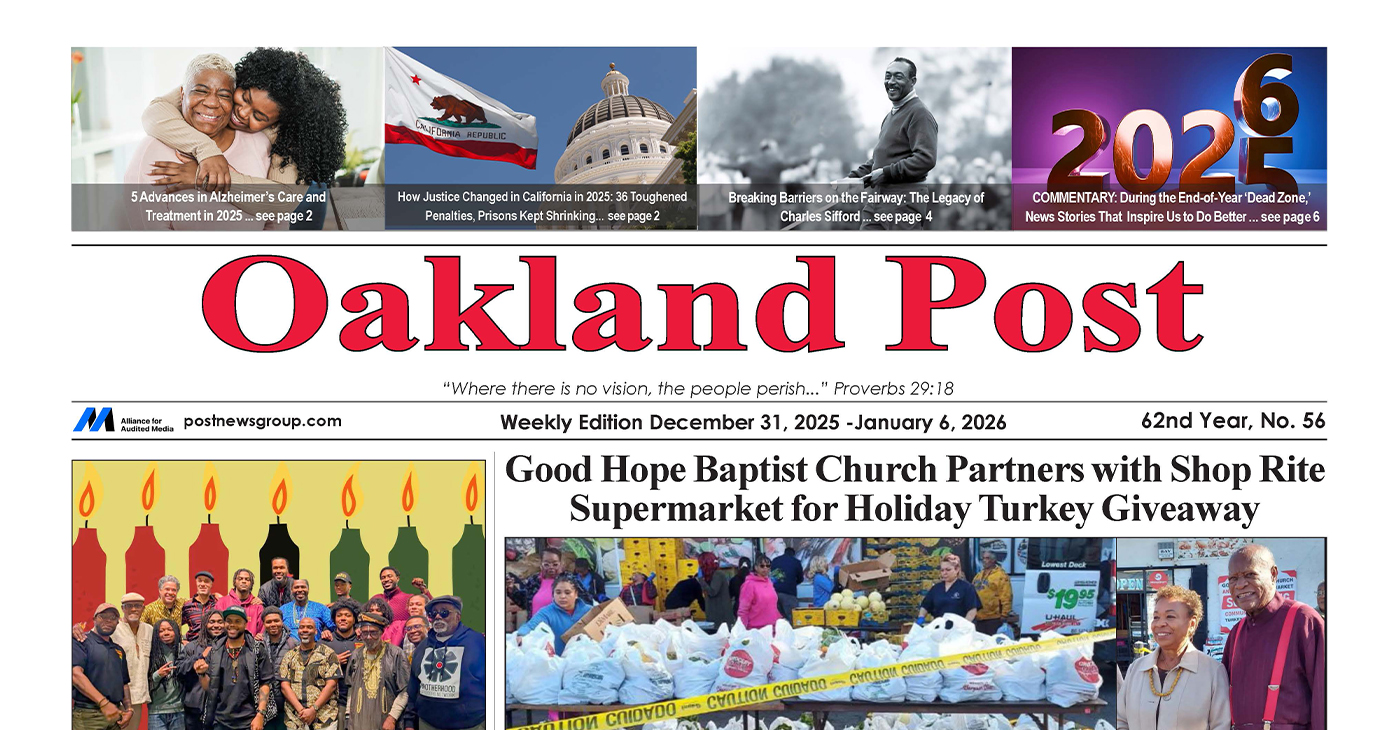
To enlarge your view of this issue, use the slider, magnifying glass icon or full page icon in the lower right corner of the browser window.
Activism
Big God Ministry Gives Away Toys in Marin City
Pastor Hall also gave a message of encouragement to the crowd, thanking Jesus for the “best year of their lives.” He asked each of the children what they wanted to be when they grow up.

By Godfrey Lee
Big God Ministries, pastored by David Hall, gave toys to the children in Marin City on Monday, Dec. 15, on the lawn near the corner of Drake Avenue and Donahue Street.
Pastor Hall also gave a message of encouragement to the crowd, thanking Jesus for the “best year of their lives.” He asked each of the children what they wanted to be when they grew up.
Around 75 parents and children were there to receive the presents, which consisted mainly of Gideon Bibles, Cat in the Hat pillows, Barbie dolls, Tonka trucks, and Lego building sets.
A half dozen volunteers from the Big God Ministry, including Donnie Roary, helped to set up the tables for the toy giveaway. The worship music was sung by Ruby Friedman, Keri Carpenter, and Jake Monaghan, who also played the accordion.
Big God Ministries meets on Sundays at 10 a.m. at the Mill Valley Community Center, 180 Camino Alto, Mill Valley, CA Their phone number is (415) 797-2567.
Activism
First 5 Alameda County Distributes Over $8 Million in First Wave of Critical Relief Funds for Historically Underpaid Caregivers
“Family, Friend, and Neighbor caregivers are lifelines for so many children and families in Alameda County,” said Kristin Spanos, CEO, First 5 Alameda County. “Yet, they often go unrecognized and undercompensated for their labor and ability to give individualized, culturally connected care. At First 5, we support the conditions that allow families to thrive, and getting this money into the hands of these caregivers and families at a time of heightened financial stress for parents is part of that commitment.”

Family, Friend, and Neighbor Caregivers Can Now Opt Into $4,000 Grants to Help Bolster Economic Stability and Strengthen Early Learning Experiences
By Post Staff
Today, First 5 Alameda County announced the distribution of $4,000 relief grants to more than 2,000 Family, Friend, and Neighbor (FFN) caregivers, totaling over $8 million in the first round of funding. Over the full course of the funding initiative, First 5 Alameda County anticipates supporting over 3,000 FFN caregivers, who collectively care for an estimated 5,200 children across Alameda County. These grants are only a portion of the estimated $190 million being invested into expanding our early childcare system through direct caregiver relief to upcoming facilities, shelter, and long-term sustainability investments for providers fromMeasure C in its first year. This investment builds on the early rollout of Measure C and reflects a comprehensive, system-wide strategy to strengthen Alameda County’s early childhood ecosystem so families can rely on sustainable, accessible care,
These important caregivers provide child care in Alameda County to their relatives, friends, and neighbors. While public benefits continue to decrease for families, and inflation and the cost of living continue to rise, these grants provide direct economic support for FFN caregivers, whose wages have historically been very low or nonexistent, and very few of whom receive benefits. As families continue to face growing financial pressures, especially during the winter and holiday season, these grants will help these caregivers with living expenses such as rent, utilities, supplies, and food.
“Family, Friend, and Neighbor caregivers are lifelines for so many children and families in Alameda County,” said Kristin Spanos, CEO, First 5 Alameda County. “Yet, they often go unrecognized and undercompensated for their labor and ability to give individualized, culturally connected care. At First 5, we support the conditions that allow families to thrive, and getting this money into the hands of these caregivers and families at a time of heightened financial stress for parents is part of that commitment.”
The funding for these relief grants comes from Measure C, a local voter-approved sales tax in Alameda County that invests in young children, their families, communities, providers, and caregivers. Within the first year of First 5’s 5-Year Plan for Measure C, in addition to the relief grants to informal FFN caregivers, other significant investments will benefit licensed child care providers. These investments include over $40 million in Early Care and Education (ECE) Emergency Grants, which have already flowed to nearly 800 center-based and family child care providers. As part of First 5’s 5-Year Plan, preparations are also underway to distribute facilities grants early next year for child care providers who need to make urgent repairs or improvements, and to launch the Emergency Revolving Fund in Spring 2026 to support licensed child care providers in Alameda County who are at risk of closure.
The FFN Relief Grants recognize and support the essential work that an estimated 3,000 FFN caregivers provide to 5,200 children in Alameda County. There is still an opportunity to receive funds for FFN caregivers who have not yet received them.
In partnership with First 5 Alameda County, Child Care Payment Agencies play a critical role in identifying eligible caregivers and leading coordinated outreach efforts to ensure FFN caregivers are informed of and able to access these relief funds.FFN caregivers are eligible for the grant if they receive a child care payment from an Alameda County Child Care Payment Agency, 4Cs of Alameda County, BANANAS, Hively, and Davis Street, and are currently caring for a child 12 years old or younger in Alameda County. Additionally, FFN caregivers who provided care for a child 12 years or younger at any time since April 1, 2025, but are no longer doing so, are also eligible for the funds. Eligible caregivers are being contacted by their Child Care Payment Agency on a rolling basis, beginning with those who provided care between April and July 2025.
“This money is coming to me at a critical time of heightened economic strain,” said Jill Morton, a caregiver in Oakland, California. “Since I am a non-licensed childcare provider, I didn’t think I was eligible for this financial support. I was relieved that this money can help pay my rent, purchase learning materials for the children as well as enhance childcare, buy groceries and take care of grandchildren.”
Eligible FFN caregivers who provided care at any time between April 1, 2025 and July 31, 2025, who haven’t yet opted into the process, are encouraged to check their mail and email for an eligibility letter. Those who have cared for a child after this period should expect to receive communications from their child care payment agency in the coming months. FFN caregivers with questions may also contact the agency they work with to receive child care payments, or the First 5 Alameda help desk, Monday through Friday, from 9 a.m. to 5:00 p.m. PST, at 510-227-6964. The help desk will be closed 12/25/25 – 1/1/26. Additional grant payments will be made on a rolling basis as opt-ins are received by the four child care payment agencies in Alameda County.
Beginning in the second year of Measure C implementation, FFN caregivers who care for a child from birth to age five and receive an Alameda County subsidized voucher will get an additional $500 per month. This amounts to an annual increase of about $6,000 per child receiving a subsidy. Together with more Measure C funding expected to flow back into the community as part of First 5’s 5-Year Plan, investments will continue to become available in the coming year for addressing the needs of childcare providers in Alameda County.
About First 5 Alameda County
First 5 Alameda County builds the local childhood systems and supports needed to ensure our county’s youngest children are safe, healthy, and ready to succeed in school and life.
Our Mission
In partnership with the community, we support a county-wide continuous prevention and early intervention system that promotes optimal health and development, narrows disparities, and improves the lives of children from birth to age five and their families.
Our Vision
Every child in Alameda County will have optimal health, development, and well-being to reach their greatest potential.
Learn more at www.first5alameda.org.
-

 Bay Area3 weeks ago
Bay Area3 weeks agoPost Salon to Discuss Proposal to Bring Costco to Oakland Community meeting to be held at City Hall, Thursday, Dec. 18
-

 Activism3 weeks ago
Activism3 weeks agoMayor Lee, City Leaders Announce $334 Million Bond Sale for Affordable Housing, Roads, Park Renovations, Libraries and Senior Centers
-

 Activism4 weeks ago
Activism4 weeks agoOakland Post: Week of December 10 – 16, 2025
-

 Activism3 weeks ago
Activism3 weeks agoOakland School Board Grapples with Potential $100 Million Shortfall Next Year
-

 Arts and Culture3 weeks ago
Arts and Culture3 weeks agoFayeth Gardens Holds 3rd Annual Kwanzaa Celebration at Hayward City Hall on Dec. 28
-

 Activism3 weeks ago
Activism3 weeks ago2025 in Review: Seven Questions for Black Women’s Think Tank Founder Kellie Todd Griffin
-

 Advice3 weeks ago
Advice3 weeks agoCOMMENTARY: If You Don’t Want Your ‘Black Card’ Revoked, Watch What You Bring to Holiday Dinners
-

 Activism3 weeks ago
Activism3 weeks agoAnn Lowe: The Quiet Genius of American Couture






